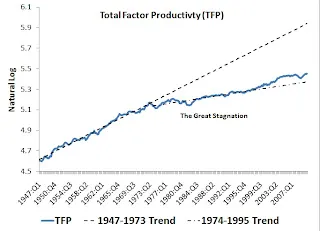Boom, Bubbles and the End of Stagnation - Byrne Hobart and Tobias Huber
Book Title:
Boom, Bubbles and the End of Stagnation
Author:
Byrne Hobart and Tobias Huber
Genre:
Economic Development, Stagnation, Technology, Essay
Synopsis:
Economists traditionally explain economic growth through two primary factors:
- Increasing inputs (such as labor hours and capital)
- Improving the efficiency with which those inputs are used
That second factor—the elusive efficiency gain that remains after accounting for all measurable inputs—is called Total Factor Productivity (TFP). TFP captures technological innovation, process improvements, and other advances that enable us to produce more with the same resources.
Over the past 150 years, TFP gains have accounted for more than half the growth in U.S. labor productivity, contributing even more than increases in capital per worker. However, TFP gains have slowed significantly since the 1970s, and many experts argue that this stagnation explains the current period of techno-economic stagnation.

In their book Boom, Byrne Hobart and Tobias Huber examine the causes of today’s stagnation and propose solutions to escape it. They argue that techno-financial bubbles—particularly “inflection bubbles”—are key drivers of both technological and financial development. According to the authors, accelerating these bubbles could help humanity reach “technological escape velocity” and break free of stagnation.
The Bubble Thesis
The authors present their thesis in several steps: Analyzing the roots of stagnation and its ideological underpinnings. Proposing the “techno-economic bubble” as the best catalyst for a new technological revolution. Offering case studies that illustrate the role of inflection bubbles, including the Manhattan Project, the Apollo program, corporate R&D (chips and semiconductors), fracking, and Bitcoin. Advancing a teleological view of progress, proposing a “theology of progress” aimed at reaching escape velocity.
Stagnation
The authors begin by diagnosing a sense of stagnation and decay in the Western world—seen in crumbling infrastructure, sluggish wage growth, declining scientific output, and a more general cultural malaise. They outline two broad theories of stagnation:
Natural Theory of Stagnation
Stagnation arises from factors beyond human control: demographic decline, environmental limits (energy or resource shortages), diminishing returns on education, and the exhaustion of “low-hanging fruit” in scientific discovery.
Social Theory of Stagnation
Increased financialization and commodification have diverted capitalism away from producing tangible goods toward “spreadsheet thinking.” Declining fertility rates signal a growing risk aversion, with fewer young people to drive ambitious ventures. Societies have become more atomized and spiritually disengaged. Bureaucratic science funding stifles breakthroughs and hinders innovation.
How Did Humanity Get Here?
The authors argue that techno-economic bubbles fueled historical leaps in technology. A bubble, per Investopedia, is an economic cycle marked by a rapid escalation of asset prices, followed by a sharp contraction. Hobart and Huber identify two types of bubbles:
Mean Reversion Bubbles
Largely credit and real-estate bubbles based on extrapolating current trends into the future. Asset prices exceed fundamentals, but the underlying reality remains largely unchanged.
Inflection Bubbles
Centered around new technology (railways, the internet, AI, Bitcoin, etc.). Act as a coordination mechanism, rallying capital, labor, entrepreneurs, and policymakers around a bold vision of the future. They transform “technological curiosities” into mass-adopted technologies by spurring futuristic thinking and strong “animal spirits.”
Case Studies
The authors examine historical “inflection bubbles,” such as:
- The Manhattan Project – Driven by a mission to build “the ultimate weapon” and end all wars.
- The Apollo Program – Centered on putting humans on the moon.
- Corporate R&D and Semiconductors – Early chip development and the legendary returns from silicon technology.
- Fracking – A transformative (and controversial) technology in the energy sector.
- Bitcoin – A vision of a radically different monetary system.
Despite their different contexts, all these examples share:
- A cult-like belief in the mission.
- A small group of visionaries pushing forward.
- Organized people and capital directed toward a shared goal.
Conclusion: Embracing the Bubble
In Boom, Hobart and Huber ultimately contend that techno-economic bubbles, especially inflection bubbles, are vital for humanity’s continued progress. Rather than treating bubbles as irrational phenomena that must be controlled, the authors suggest that these “bubbles” are actually essential mechanisms for coordinating resources and achieving breakthroughs.
They warn that contemporary economic frameworks and regulatory environments might be too risk-averse to allow for the kinds of bubbles that catalyze real advancement. For policymakers and investors, the takeaway is clear: instead of simply trying to prevent all bubbles, they should learn to distinguish between harmful mean-reverting bubbles and inflection bubbles that can drive technological progress.
Finally, the book closes on a moral argument: enabling progress through these mechanisms is both economically and ethically necessary if humanity is to meet pressing global challenges and realize its full potential.